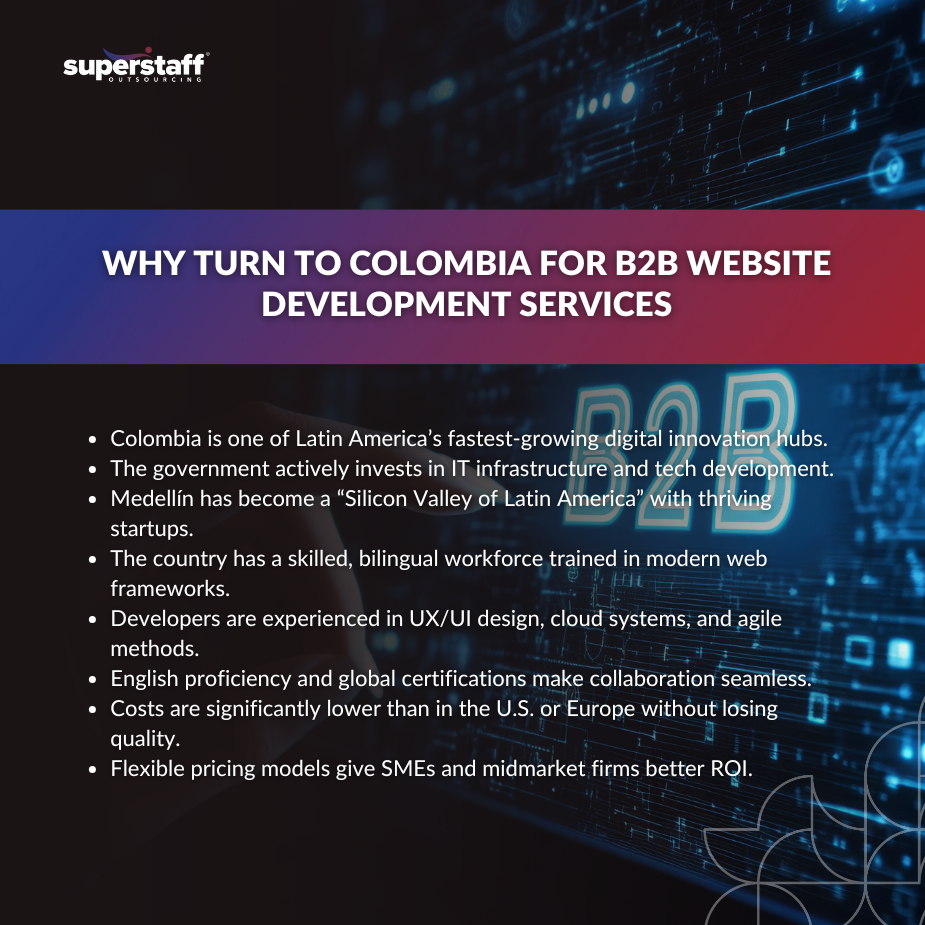
Rising digital demands have made B2B website development services a crucial competitive differentiator. As businesses compete for market share in an increasingly online economy, a company’s website is no longer just a branding tool; it’s a vital platform for customer acquisition, engagement, and conversion.
From seamless UX design to real-time analytics integration, every element of a B2B site can determine whether a business thrives or falls behind.
To meet these growing demands, U.S. and global companies are turning to nearshore solutions that combine speed, quality, and cost efficiency. Nearshoring allows teams to collaborate in real time, ensuring projects stay agile and aligned with business goals. Among Latin American destinations, Colombia stands out as a powerhouse for digital innovation.
Colombia’s blend of skilled developers, modern tech infrastructure, and strategic proximity to North America has positioned it as a leader in B2B website development services. With a thriving tech ecosystem and a strong bilingual workforce, Colombian firms deliver scalable, high-quality websites tailored to the needs of global enterprises.
This blog explores why outsourcing website development to Colombia offers more than just savings; it’s a strategic move that gives businesses a genuine competitive edge in today’s fast-paced digital economy.
Colombia Is Fast Becoming a Digital Innovation Hub in Latin America
Colombia is fast becoming a digital innovation hub in Latin America, making the country ideal for B2B website development services. Over the last decade, Colombia’s information technology and software industry has expanded rapidly, increasingly contributing to national GDP and export revenues.
According to ProColombia, in 2023 the software and IT sector accounted for 3 % of Colombia’s GDP and achieved sector sales of approximately USD 2.17 billion, with consistent double-digit export growth over preceding years. The industry is among the fastest-growing in Latin America, with projections toward a $2.77 billion valuation by 2029, driven by cloud, AI, and digital services demand.
Meanwhile, Colombia’s broader ICT (information & communications technology) sector saw growth of 14.6 % in 2022 (in USD terms), reflecting surging demand for software and digital infrastructure.
This growth is underpinned by supportive government policies, incentives, and investment in connectivity. National programs have prioritized expanding internet access, bridging the digital divide, and stimulating innovation hubs in secondary cities. Stronger broadband, mobile networks, and data infrastructure are creating better environments for complex web and web app projects.
Medellín as a “Silicon Valley of Latin America,” foreign investment, strong startup ecosystem
One of the most vivid centers of innovation is the city of Medellín. Once known for its industrial past, Medellín has worked hard to rebrand itself as a knowledge- and technology-driven metropolis. The creation of Ruta N — a publicly backed innovation district in the north of Medellín — has anchored this transformation.
Ruta N provides coworking and innovation space, grant support and infrastructure to technology companies, and hosts “landing programs” for international firms that want to set up operations in the area. In 2025, Ruta N launched its “Medellín Next” initiative, selecting 25 tech-based enterprises (startups and scaleups) for intensive support and global scaling.
The city hosts over 400 startups, making up a significant share of Colombia’s startup ecosystem. Medellín also ranks highly in StartupBlink’s global ecosystem index and is second within Colombia in startup density. Notable companies such as Rappi maintain a strong presence in Medellín, providing anchor examples of how Colombian tech can scale regionally.
Such momentum has drawn foreign direct investment into Colombia’s tech sector. Firms in fintech, healthtech, and software-as-a-service (SaaS) are investing in Colombian operations, attracted by talent, incentives, and growing regional demand. The country has also seen an influx of venture capital into local startups, reinforcing the ecosystem’s dynamism.
Beyond macroeconomic factors, Colombia’s talent pool makes it especially attractive when evaluating B2B web development services for international firms.

Colombia Offers a Highly Skilled and Bilingual Workforce for B2B Website Development
Colombia offers a highly skilled and bilingual workforce for B2B website development services. One of its strongest assets is its deep bench of technical talent. The country is home to thousands of software developers, a number that continues to grow each year.
Many of these developers are versed in modern frameworks (React, Angular, Vue.js), backend stacks (Node.js, Python, Java, .NET), and full-stack capabilities. Additionally, there is growing expertise in emerging areas such as cloud-native architectures, microservices, container platforms (Docker, Kubernetes), and serverless solutions.
Because B2B websites increasingly require integrations (APIs, CRMs, marketing automation, ERP systems), Colombian development teams often have experience building complex, scalable systems. Their skills extend into responsive/mobile-first design, UX/UI prototyping, and user-centric design thinking — all of which matter in high-stakes B2B environments.
English proficiency, certifications, partnerships with global tech institutions
For outsourcing to work smoothly, communication is key. Many Colombian tech professionals possess strong English proficiency, especially in major tech hubs where exposure to international clients is common. Tech firms often factor this into hiring, training, or selecting senior staff who can serve as client liaisons.
Moreover, many developers hold international certifications (Azure, AWS, Cisco, Scrum, etc.) and have completed training or bootcamps aligned with global standards. Some Colombian universities have established partnerships or exchange programs with global tech firms, further aligning curricula with international best practices. In Medellín, for example, the Georgia Tech Medellín Center is a collaboration that fosters innovation, university–industry cooperation, and training.
These capabilities make Colombian teams comfortable working in cross-border, agile development environments, reducing friction in delivering web app development services and web development services to global clients.
Skill alone is not enough; cost efficiency makes the case even stronger when comparing Colombia to U.S. or European markets.
Cost Efficiency Without Compromising Quality Gives Colombia an Edge Over U.S. and European Markets
Cost efficiency without compromising quality gives Colombian B2B website development services an edge over U.S. and European markets.
Comparison of development costs: Colombia vs. U.S. and Europe
A critical driver of outsourcing decisions is cost. On average, labor and overhead costs for web and software development in Colombia are significantly lower than in the U.S. or Western Europe. While senior developers in the U.S. can command rates of $100–$200+ per hour (or more depending on specialization), Colombian teams often provide equivalent skill sets at a fraction of that cost, depending on complexity and seniority. (Note: precise rates vary by project, specialization, and firm.)
Because overhead — office space, benefits, equipment, etc. — is also lower in Colombia, total project costs can be more favorable while still maintaining high-quality standards.
Flexible pricing models, better ROI for SMEs and midmarket firms
Colombian development firms frequently offer flexible pricing models such as fixed-price, time-and-materials, or hybrid retainers. This flexibility allows clients (especially SMEs and midmarket B2B companies) to scale scope up or down without enduring rigid contracts or cost blowouts.
From the perspective of ROI, companies can reallocate savings toward marketing, product development, or client acquisition. For many midmarket firms, partnering with Colombian teams enables them to punch above their weight, obtaining enterprise-grade web development services without the prohibitively high price tag of U.S./European agencies.
Cost savings help, but proximity and operational advantages further enhance Colombia’s appeal.
Nearshore Alignment with North America Enhances Collaboration and Delivery Speed
Nearshore alignment with North America enhances collaboration and delivery speed. One of Colombia’s major advantages as a nearshore destination is its time zone compatibility with many U.S. markets.
Much of Colombia operates on UTC-5, which aligns closely with the U.S. Eastern Time without large offsets. This overlap enables real-time collaboration during core business hours. Project meetings, design reviews, daily sprints, and ad-hoc troubleshooting become much more seamless.
Cultural affinity also helps. Colombians tend to have strong work ethics, an orientation toward meeting deadlines, and familiarity with U.S.-style business practices (thanks to increased cross-border engagement). This reduces miscommunication, misunderstandings, or delays that often occur when working across vastly different cultural norms.
Agile project management, shorter turnaround times, synchronous feedback loops
When teams are distributed across distant time zones (e.g. U.S. and Southeast Asia), feedback loops can stretch out. A design review submitted in the evening might not be reviewed until the next morning, adding latency to the iteration cycle. Because Colombian teams share overlapping hours, responsiveness is faster. Clients and developers can iterate more nimbly, catch issues earlier, and maintain momentum.
This alignment supports agile workflows and continuous delivery. The ability to run daily stand-ups, sprint planning sessions, and backlog grooming in overlapping windows transforms how international clients can utilize B2B website development services.
With these logistical advantages in place, Colombian developers also bring strong innovation capabilities to the table.
Colombian B2B Developers Are Driving Innovation in Web Technologies
Colombian B2B website development services are driving innovation in web technologies. Beyond “standard” site development, Colombian teams are increasingly building advanced, future-ready systems. Many are proficient in cloud platforms (AWS, Azure, Google Cloud), enabling scalable, distributed architecture. They integrate analytics, serverless functions, AI-driven modules, chatbots, and personalization engines into B2B websites and web apps.
In sectors like e-commerce, fintech, and logistics, B2B clients demand features like subscription engines, secure payment gateways, real-time inventory modules, and microservices integrations. Colombian software developers have delivered systems along those lines, proving they can handle end-to-end complexity. Mobile-first and responsive design is considered standard, not optional, especially as B2B buyers expect excellent experiences on mobile devices.
Case examples of Colombian companies delivering innovative solutions
One relevant example is Loggro, headquartered in Medellín. Loggro provides SaaS solutions for SMEs, including ERP, point-of-sale, and payment processing tools. It illustrates how homegrown Colombian software firms are leveraging cloud-native, integrated architectures.
Another example: Colombia’s tech startup ecosystem produces firms like Rappi, which although primarily a consumer-facing “super app,” has developed complex backend systems, logistics APIs, and scaling models that attract engineering talent and know-how. These practices spill over into the B2B web development culture as engineers migrate or partner across industries.
Programs like Medellín’s Ruta N also help scale tech firms from local to global stages, reinforcing capacity for complex, innovation-led web app development services.
The result is that Colombian firms are no longer limited to “outsourced coding” roles — many deliver architects, product design thinking, cloud strategy, and ongoing optimization. This is a critical differentiator when selecting a partner for B2B website development in competitive verticals.
Ultimately, the collective effect of Colombia’s macro environment, talent, cost structure, operational alignment, and innovation intensity combine to deliver a clear competitive edge in the digital economy.
Turn to SuperStaff Colombia for B2B Website Development Services
Colombia’s unique blend of strengths—deep technical talent, cost-effective delivery, time-zone alignment, cultural affinity, and innovation readiness—makes it a compelling destination for outsourcing B2B website development services and web app development services. The country is increasingly recognized as a hub where global businesses can collaborate with high-performing teams without the risks of traditional offshore imbalance.
If your B2B company is evaluating nearshore partners for website or web app development, exploring partnerships with the Colombian teams at SuperStaff offers a meaningful strategic advantage. Consider engaging firms or agencies in Medellín, Bogotá, or other growing tech hubs in Colombia to pilot a project, gauge responsiveness, and align on innovation goals.
In a rapidly digitalized economy, the right web strategy partner can make the difference between lagging behind and staying ahead. Contact us today to get started.






